NVIDIA Teases GeForce RTX 2080 Performance Numbers, Announces Ansel RTX
by Nate Oh on August 22, 2018 3:50 PM EST- Posted in
- GPUs
- NVIDIA
- Deep Learning
- Turing
- GeForce RTX
- DLSS
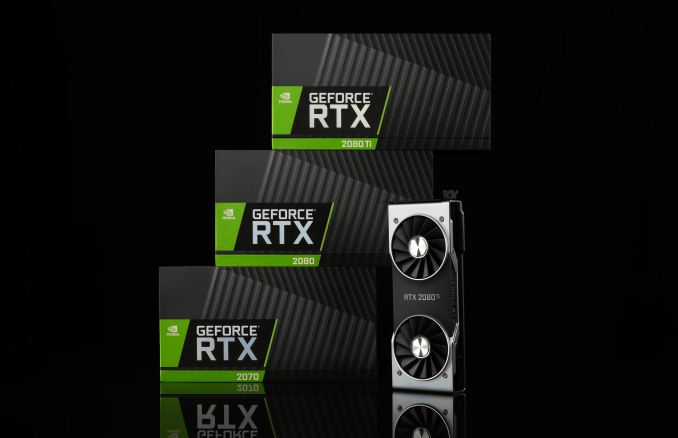
Concluding their Gamescom festivities for their newly-introduced GeForce RTX 20-series, NVIDIA has revealed a bit more about the hardware, its features, and its expected performance this evening. Tonight NVIDIA is announcing the new Ansel RTX features in GeForce Experience, as well as some game performance metrics for the GeForce RTX 2080 up against the GeForce GTX 1080. After recent hands-on demos featuring real-time raytracing, NVIDIA is offering some numbers for out-of-the-box and Deep Learning Super Sampling (DLSS) performance in traditionally rendered games.
| NVIDIA RTX Support for Games As of August 20, 2018 |
||||
| Game | Real-Time Raytracing | Deep Learning Super Sampling (DLSS) | ||
| Ark: Survival Evolved | - | Yes | ||
| Assetto Corsa Competizione | Yes | - | ||
| Atomic Heart | Yes | |||
| Battlefield V | Yes | - | ||
| Control | Yes | - | ||
| Dauntless | - | Yes | ||
| Enlisted | Yes | - | ||
| Final Fantasy XV | - | Yes | ||
| Fractured Lands | - | Yes | ||
| Hitman 2 | - | Yes | ||
| Islands of Nyne | - | Yes | ||
| Justice | Yes | |||
| JX3 | Yes | |||
| MechWarrior 5: Mercenaries | Yes | |||
| Metro Exodus | Yes | - | ||
| PlayerUnknown's Battlegrounds | - | Yes | ||
| ProjectDH | Yes | - | ||
| Remnant: From the Ashes | - | Yes | ||
| Serious Sam 4: Planet Badass | - | Yes | ||
| Shadow of the Tomb Raider | Yes | - | ||
| The Forge Arena | - | Yes | ||
| We Happy Few | - | Yes | ||
Starting with NVIDIA’s DLSS – and real-time raytracing for that matter – we already know of the supported games list. What they are disclosing today are some face-value 4K performance comparisons and results. For DLSS, for now we can only say that it uses tensor core-accelerated neural network inferencing to generate what NVIDIA is saying will be high-quality super sampling-like anti aliasing. Though for further technical information, this is a project NVIDIA has been working on for a while, and they have published some blogs and papers with some more information on some of the processes used. At any rate, the provided metrics are sparse on settings or details, and notably measurements include several games rendered in HDR (though HDR shouldn't have a performance impact).
Otherwise, NVIDIA presented a non-interactive Epic Infiltrator 4K demo that was later displayed on the floor, comparing Temporal Anti Aliasing (TAA) to DLSS, where the latter provided on-average near-identical-or-better image quality but at a lower performance cost. In this case, directly improving framerates. To be perfectly honest, I spent the entire floor time talking with NVIDIA engineers and driver/software developers, so I have no pictures of the floor demo (not that anything less than a direct screenshot will really do it justice). Ultimately, the matter of DLSS is somewhat nuanced and there isn’t much we can add at the moment.
Overall, the idea is that even in traditionally rasterized games without DLSS, the GeForce RTX 2080 brings around 50% higher performance than the GeForce GTX 1080 under 4K HDR 60Hz conditions. Because this excludes real-time raytracing or DLSS, this would be tantamount to ‘out of the box’ performance. Though there were no graphics settings or driver details to go with these disclosed framerates, so I'm not sure I'd suggest reading into these numbers and bar charts one way or another.
Lastly, NVIDIA announced several new features, filters, and supported games for GeForce Experience’s Ansel screenshot feature. Relating to GeForce RTX, one of the features is Ansel RT for supported ray-traced games, where a screenshot can be taken with a very high number of rays, unsuitable for real-time but not an issue for static image rendering.
Ansel RTX also leverages a similar concept to the tensor core accelerated DLSS with ‘AI Up-Res’ super resolution, which also works for games not integrated with Ansel SDK.
In terms of the GeForce RTX performance, this is more-or-less a teaser of things to come. But as always with unreleased hardware, judgement should be reserved until objective measurements and further details. We will have much more to say when the time comes.


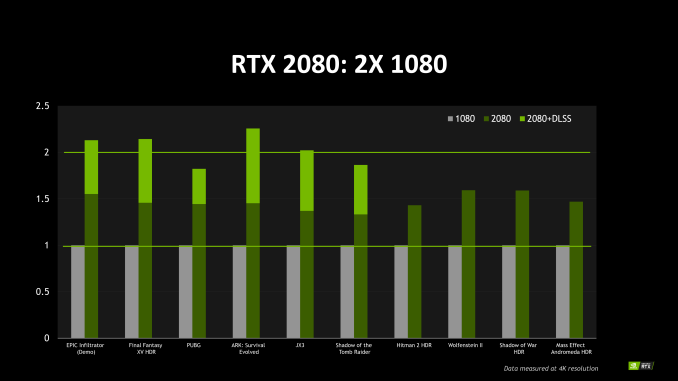
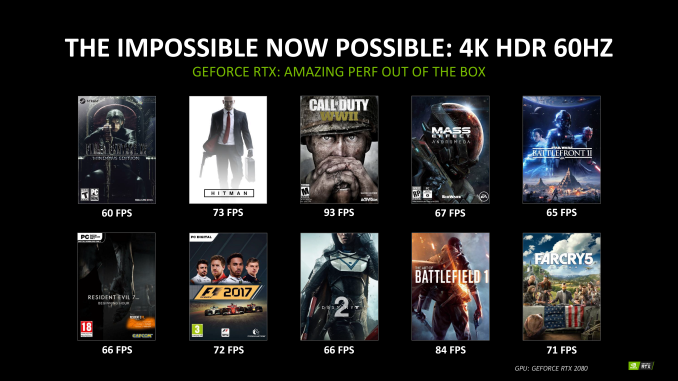
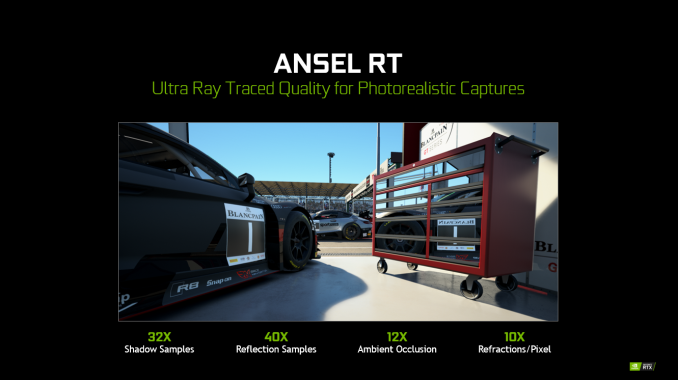
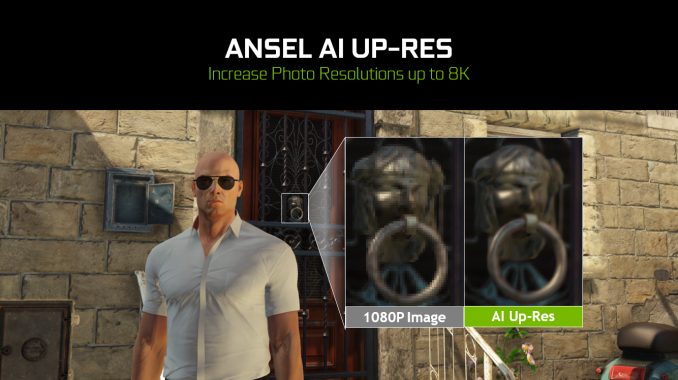








92 Comments
View All Comments
darckhart - Wednesday, August 22, 2018 - link
Yea I clicked this article because it said "performance numbers" and all I see is a bar graph with some BS y-axis that is not fps.Manch - Thursday, August 23, 2018 - link
If this is indeed a stumble by Nvidia, unfortunately AMD is nowhere around to capitalize. I like Nvidia cards well enough but the prices have been climbing due to a lack of competition from AMD. They're getting obnoxiously expensive mining craze aside. I'll hang onto my 290X's and 1060's for a while longer. 30% improvement for 50% price increase BS. I'll hang back and wait as well but you're right. Something smells. vendor agnostic MGPU gaming cant come soon enough.vailr - Wednesday, August 22, 2018 - link
Has anyone at the Gamescom event been able to check the Windows Device Manager for the Nvidia driver version? Do they allow any unsupervised playing time with the demo machines? Although it seems kind of doubtful they would permit that. But if so: shouldn't be too difficult to boot a portable SSD running "Windows to Go", copy over & install the Nvidia device drivers from the system's internal boot drive, and obtain some initial GPU-Z screen shots or maybe some crypto-mining benchmarks, for example.HollyDOL - Thursday, August 23, 2018 - link
Ugh... Remembering huge availability issues to get my current 1080 I really hope this card cannot cryptomine.wyatterp - Thursday, August 23, 2018 - link
So this RTX2080 will eclipse the existing 1080TI out of the box?If so, why is everyone so damn salty? The 1080TI is not a "$529" card - used sales don't count. I'm seeing 1080TI's still going for $750+. Even if they drop prior to launch - that's not what the 1080TI cost right up until the RTX2080 launch. If you are the type that thinks RayTracing is just a "gimmick" and don't buy NVidia's push here (which is fine), you can still get a 1080TI which suddenly became old news and probably 100-200 cheaper (by October).
I for one am not seeing anything that should dissuade me on my preorder. Yes, it's hella expensive, but so is the 1080TI, a card I previously scoffed at as ridiculous. I think realtime Ray-tracing is going to be the future, and faster than everyone thinks.
Yojimbo - Thursday, August 23, 2018 - link
We live in a complicated communications environment. Firstly, it only takes a small percentage of people to create a hubbub because there are so many people to begin with. It can look like lots and lots are salty even when it's only a small percentage. Then that can snowball until it actually is lots of people. Secondly, there are fanboys who aren't even trying to be reasonable. They just say whatever to try support their fandom. Thirdly, you have bloggers and journalists that are competing fiercely for clicks. They get more clicks by being emotional and alarmist than being reasonable. So saying "Something is fishy with the presentation. Deviousness is afoot. The performance must be bad. Resist the hype!" gets more clicks than saying "Perhaps the new cards don't offer a sizable performance boost in legacy games compared to the old ones, but perhaps NVIDIA just wanted to hype up the ray tracing abilities without distraction. We have to wait until we get more information."wyatterp - Thursday, August 23, 2018 - link
You are right, and it is unfortunate the internet has become the megaphone of the negative. It collates every negative opinion quickly from folks the world over into singular forums.Early on - the internet seemed to thrive with more excitement and hype. Hype is dead - I'd hate to face the comments if I were an NVidia engineer.
I do think the video played of Shadow of the Tomb Raider gameplay wasn't impressive from a ray tracing perspective, but it also is a scene that fairs well with existing rasterization techniques (vs the night scene they showcased in the on-stage demo). I saw a handy cam capture of the BFV demo (beyond what was on the stage demo released to public) - and that is a way more eye opening demonstration of what ray tracing is capable of.
It's incredible that we can, in one generation, run games at playable framerates AT ALL using all ray tracing. Which bodes well for the transformation - even if many will not like that it means 30-60FPS on very expensive cards. This is how it will always work - like new tech in expensive luxury cars. It will be more fascinating if the RTX2070 can support 30FPS in ray-tracing in most games at 1080-1440P. That's still an incredible feat that our jaded cynical world wide web will dump all over.
Skiddywinks - Thursday, August 23, 2018 - link
But it isn't all raytracing. Not even close. That's years and years away.What this is, is a tentative effort at a paradigm shift to start making raytracing the standard.
The problem is, a lot of people (myself included) buy based on performance, and raytracing even only the things that are raytraced appears to bring some rather disappointing performance to the games that have the option enabled.
Couple this with people not only being eager for some new cards to spend their shinies on, but also having literally only just gotten out of months of excessively high card prices, the appeal of forking out over a grand for what appears to be around a 20% at best traditional performance improvement on a model Vs model basis has left a very sour taste in many people's mouths.
I'm all for the progression of tech. I spent way over the odds for an SSd back in the day, but that improved performance. The level RT is at currently seems more like a side upgrade, and I think a lot of people feel the way I do, and would rather a range of cards that cost significantly less and cannot do RT, or cost the same and sacrifice RT cores etc for higher clocks or more traditional cores.
Yojimbo - Thursday, August 23, 2018 - link
I don't think ray tracing is years and years away.As far as what people prefer, well, my opinion is they have their habits. They skip over visual artifacts but they are hypertuned to frames per second. If you're not playing competitively then what is the use of frames per second? Experiential quality. Well, to me, the differences that ray tracing make are worth more to experiential quality than some extra frames per second. I'm guessing I'd rather play at 40 fps with G-Sync and ray tracing than over 60 fps without ray tracing. That's if it's implemented well, of course.
Eventually ray tracing will enable a change in the artistic design of games, and even some game play changes. Those changes will take a longer time to come about, especially the game play ones. That can't really happen until most cards are ray tracing capable. The artistic changes will take time for the artists to relearn what is and isn't possible. But at the moment I think there's adequate low-hanging fruit that will come out to justify an extra $50 or $100 for the price of a card, even if it knocks frames per second down a bit in the process.
As far as sour taste in people's mouths, I don't buy it. I think the salty ones are a minority. Most people willing to pay that much for a graphics card are probably excited to be getting something special they don't get every generation.
eddman - Thursday, August 23, 2018 - link
I suppose you'd be ok with paying $1000 for a 3080 and $1500 for a 4080. After all, better performance warrants a higher price. By that logic a x080 card would be $4000 in a few years and users should be happy about it, right?8800 GTX, which was a massive technological step (according to nvidia), launched at the SAME price point as 7800 GTX, even though it was up to two times faster or more in certain games.
It seems you've become used to being price gouged.